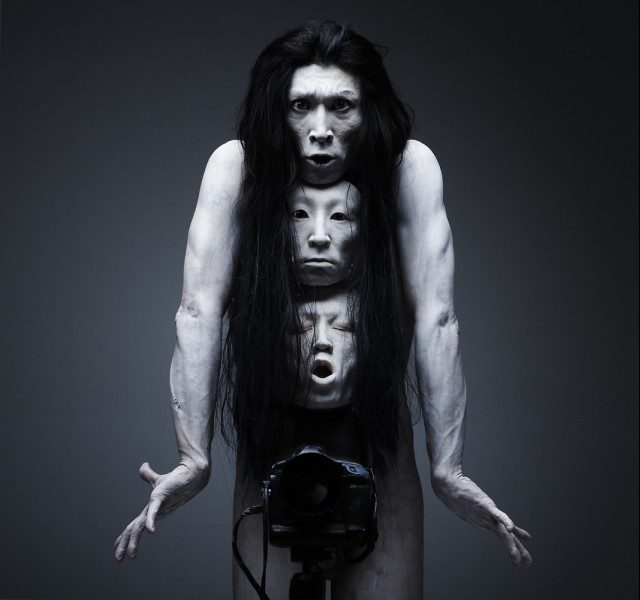Výstava veľkoformátových
fotografií z tvorby súčasného kórejského fotografa Kang Youngho:
Metamorfujúca alchýmia
fotoaparátu a zrkadla – „99 variácií“tancujúci fotograf Kang Youngho
Vzal som kľúč
(fotoaparát), otvoril som dvere do tajnej chodby (zrkadla), prebudil som
mýtické archetypy a vylákal ich von do sveta.
Pozrel som sa do
zrkadla, odfotografoval som sa a vo fantázii som začal vytvárať nové obrázky.
Inak povedané: zrkadlo sa stalo priestorom, kde som aj režisérom, aj
hercom na javisku. Hľadiac do zrkadla, tancujúc, a zároveň fotografujúc sa,
snívanie zrazu začalo pretvárať môj talent na mágiu, ktorá umožnila nekonečné
premeny. Všetko, čo bolo dôležité v tomto
bode, bol ich „vzťah“. Zachovanie súvislosti medzi mojím súčasným „ja“ a
„zrkadlom, ktoré ma odráža“. Potlačenie túžby po pozícii predmetu, vzdanie sa
samého seba uprostred vzťahu. Napokon som začal s mojím tretím ja. „Ja“ sa
rozšírilo na „ďalšie ja“, čoraz početnejšie. A potom som šiel niekam, čo
nazvem „imaginárnou ríšou“.
Našiel som tam ďalších
asi deväťdesiatdeväť „ja“. Deväťdesiatdeväť je teoretické číslo, ktoré ma
označuje z celku 100 mínus jedna – „moje
súčasné ja“.
Počas tohto procesu som
zistil, že sa vo mne skrýva muž a žena v jednom tele. Mutant. Heroický ako
bojovník, agresívny, subjektívny. Zbožné obrazy boli zatriedené do
„mužských“ obrazov, zatiaľ čo ľudské, mýtické, umelé, pasívne, inkluzívne,
objektívne obrazy boli zaradené do „ženských obrazov“. Zvyšné snímky boli
zatriedené medzi „združené snímky“ –
ani Boh, ani človek, sprostredkovateľský subjekt ako duch alebo víla. Ony
koexistujú a sú vzájomne prepojené.
Doposiaľ zobrazované
moje ja, fotografie, ktorých môže byť nespočetne veľa, udržiavajú vzťah
pri pohľade na seba cez zrkadlo fotoaparátu, aj keď sa môžu zdať rozptýlené.
Takýto vzťah prináša určitý poriadok a štruktúru. Preto nazývam svoju pracovnú
metódu novým žánrom – obrazovýmrozprávaním.
Líši sa od rozprávania príbehov, a predsa zahŕňa „rozprávanie príbehov“ v
rovnakom čase. Verím, že obrazové
rozprávanie môže siahať až za hranice
rozprávania, ktoré je založené na jazykovej predstavivosti.
Obrazové rozprávanie je rovnaké, ako keď prezentujeme divákom nástroje
na lepšiu predstavivosť, niečo blízke novému hudobnému nástroju namiesto už
dokončenej hudby alebo príbehu. Preto žiadny fixný príbeh nemôže existovať
bez obrazového rozprávania. To poskytuje príležitosť pre snívanie a otvára
dvere do sveta fantázie. Z tohto dôvodu
som sa rozhodol dať svojej práci názov „Zmeny„, čo je dôležitá
vlastnosť obrazového príbehu.
Po približne 99 obrazoch
sa vyberiem späť cestou, ktorou som prišiel až do tohto bodu, a prehodnotím
silu predstavivosti, význam obrazov a ich vzájomný vzťah.
The
metamorphic alchemy of the camera and mirror – “99 Variations”
By The Dancing Photographer Kang Youngho
I brought
a key (the camera), opened the door to the secret passage (the mirror), woke up
my mythical archetypes, and lured them out into the world.
I looked into the mirror, photographed myself,
and created new images through my imagination. In other words, the mirror became the space where I am
both the director and the actor on stage. Looking into the mirror, dancing, and
at the same time photographing myself, daydreaming started to transform my
talent into magic, which allowed infinite metamorphoses. All that was important
at this point was their ‘relationship’ as well as not losing the link between
‘my present self’ and the ‘mirror-reflected me,’ or not desiring the position
of the subject but giving up the self in the midst of relationship. Then I
started to meet my third self. ‘I’ became expanded into ‘I’s,’ ever more
numerous, and then I went someplace that I will call the “imaginative realm.”
I found about 99 ‘other me’s.’ 99 is a theoretical number that denotes
myself as a whole to be 100 minus one—‘my present self.’
During the process, I discovered that there was
androgyny (male and female in one body, mutant) hidden in myself. Heroic,
warrior-like, aggressive, subjective, godly images were classified into ‘male
images,’ while human, mythical, artificial, passive, inclusive, objective
images were classified into ‘female images.’
The remaining images were classified into ‘composite images’—neither god
nor human, a mediating entity like a spirit or a fairy. They co-exist and are interrelated.
Shown so far, fragmented self-images—which also
can be numerous Others—maintain the
relationship of looking at one another through the camera and the mirror
even though they might seem scattered. Such a relationship has a certain order
and structure. So, I am calling my work method “image-telling”—a new genre. It is separate from and embraces
“storytelling” at the same time. I believe that “image-telling” can go beyond
storytelling, which is based upon linguistic imagination.
Image-telling
is the
same as presenting spectators with the
tools for imagination, something close to a new musical instrument, instead
of already completed music or a story.
Therefore, there can be no fixed
story in image-telling. It provides an opportunity for daydreaming and
opens the door to the imagination. For that reason, for the title of my work, I
decided to use the word “variation,” which
is an important characteristic of the image-telling.
After about 99 images, I will walk back along
the road that I have traveled up to this point and rethink the power of the imagination, the meaning of the images, and their
relationship to myself.
Kang Youngho
